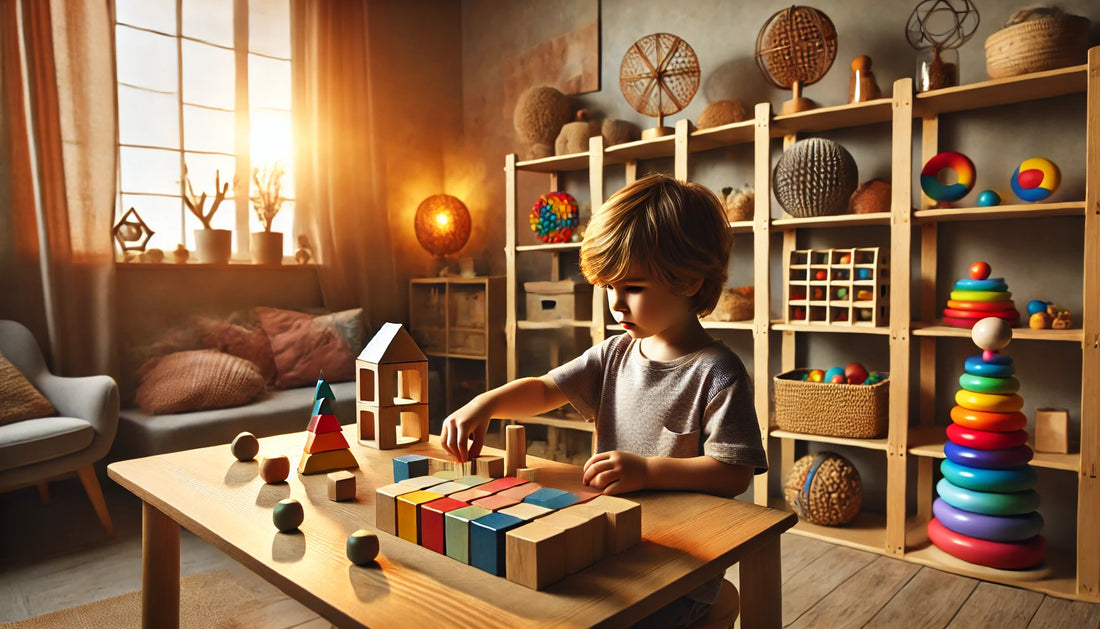
Best Toys for Kids with Autism: Sensory and Inclusive Play
Mauro VendemiattiShare
Children with autism experience the world in unique ways, and their play often reflects this. Behaviors like lining up toys or engaging in repetitive activities are more than just quirks—they are part of their sensory world and a way to self-regulate. Sensory and inclusive toys can support these needs, helping children develop essential skills while providing comfort and joy.
In this blog, we’ll explore why sensory toys are crucial for children with autism, offer tips on choosing the right toys, and share our top recommendations to enhance sensory and inclusive play.
Why Do Autistic Children Line Up Toys?
Understanding the Behavior
Lining up toys is a common behavior among children with autism. This activity can provide a sense of order and predictability, helping children create a calm and structured environment. Repetitive play, like lining up toys, is often a way to self-regulate, especially in overstimulating or unpredictable situations.
How Toys Support This Behavior
Toys that align with these needs can enhance the experience. Sensory benefits like texture, sound, and visual stimulation encourage children to explore their environment in a way that feels safe and manageable. For example, blocks and stacking toys allow for organizational play that complements their natural preferences.
What Are Sensory Toys?
Definition and Purpose
Sensory toys are designed to stimulate one or more senses—sight, sound, touch, taste, or smell. These toys help children process sensory information and improve their ability to navigate their surroundings.
Why Do Sensory Toys Help Autism?
Sensory toys play a crucial role in fostering sensory integration. For children with autism, these toys can:
- Provide calming effects to reduce anxiety.
- Improve focus and attention.
- Develop motor skills and coordination.
- Encourage interactive and exploratory play.
Examples of Sensory Toys: Fidget spinners, textured balls, stacking blocks, and weighted blankets are just a few of the many Educational and Learning Toys options available.
Top Toy Recommendations for Kids with Autism
Lining Up and Organizational Play
- Blocks and Stacking Toys: Encourage logical thinking and fine motor skills.
- Track-Building Sets: Perfect for creating order and engaging in repetitive play.
Multi-Sensory Play Options
- Weighted Blankets: Offer a soothing, calming effect.
- Textured Balls: Great for tactile stimulation and motor skill development.
- Fidget Cubes: Provide endless exploration with different textures, buttons, and movements.
Inclusive Play Ideas
- Cooperative Games: Promote interaction and teamwork.
- Soft Balls: Safe for group play while encouraging sensory exploration.
- Puzzle Sets: Engage cognitive skills while allowing collaboration with others.
How to Choose the Right Toys for Your Child
Tips for Parents and Caregivers
- Understand Your Child’s Preferences: Observe what types of textures, sounds, or visual stimuli they enjoy.
- Opt for Multi-Functional Toys: Choose toys that grow with your child and serve multiple developmental purposes.
Safety Considerations
- Ensure toys are made from non-toxic materials.
- Look for durable options that can withstand repetitive play.
- Choose washable toys for easy maintenance.
Encouraging Playtime Interaction
Engage siblings or peers in play to promote social interaction. Opt for toys that naturally encourage cooperative play to build connections.
Frequently Asked Questions
Why do sensory toys help kids with autism?
Sensory toys support sensory integration, reduce stress, and enhance focus, making them valuable tools for children with autism.
What toys are best for calming overstimulated kids?
Weighted toys, squishy balls, and soft textured items are excellent for calming overstimulation.
How can I encourage my child to engage with sensory toys?
Introduce toys gradually and interact with your child during play to make it a shared, enjoyable experience.
Why do autistic children line up toys?
Lining up toys helps children with autism create order and consistency, which can be calming. It’s often a form of sensory self-regulation.
What are the best toys for sensory stimulation in autism?
Toys like textured balls, weighted blankets, fidget spinners, and stacking blocks provide sensory stimulation and support motor skill development.
How do sensory toys help kids with autism?
Sensory toys improve sensory integration, reduce stress, and encourage developmental skills like focus, coordination, and social interaction.
What toys are good for inclusive play for autistic children?
Cooperative games, soft balls, and sensory-friendly building sets promote inclusive play by encouraging interaction in a safe and enjoyable way.
How do I choose the right toy for a child with autism?
Choose toys based on sensory preferences, safety (non-toxic materials), and age-appropriate designs. Engage the child to discover what they enjoy most.
Conclusion
- Recap the importance of sensory and inclusive toys for children with autism.
- Encourage readers to explore the best sensory toys at GadWitch Toy store.
- Reiterate primary keyword: “autism and lining up toys.
